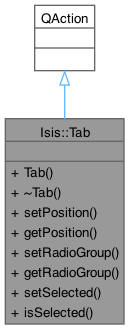|
| | Tab (QWidget *associatedWidget, QWidget *parent=0) |
| | constructs a Tab
|
| |
| virtual | ~Tab () |
| | destructs a Tab
|
| |
| void | setPosition (const int &newPosition) |
| | set the position of the Tab within a TabBar
|
| |
| const int & | getPosition () const |
| | get the position of the Tab within a TabBar
|
| |
| void | setRadioGroup (const int &newRadioGroup) |
| | Tabs which share a radio group have the property that only only one Tab in the group can be selected at a time.
|
| |
| const int & | getRadioGroup () const |
| | Tabs which share a radio group have the property that only only one Tab in the group can be selected at a time.
|
| |
| void | setSelected (bool newStatus) |
| | A selected Tab will look visually pressed and have its associatedWidget visible.
|
| |
| bool | isSelected () |
| | A selected Tab will look visually pressed and have its associatedWidget visible.
|
| |
A Tab is a QAction which shows or hides some other QWidget, which we call associatedWidget.
The Tab does not own this widget, it just stores a pointer so that it can set the widget to be visible or invisible. Tabs are toggleable. If a Tab is down then its associatedWidget is visible If a Tab is up then its associatedWidget is invisible. Tabs are designed to be added to TabBars, which are special QToolBars that can handle the management and storing of Tabs. Tabs have a "radioGroup" to which they belong, which is just an int. Tabs in the same TabBar which have the same radioGroup number have the property such that only one of the Tabs can be selected at a time. Note that the radioGroup value is only used if the TabBar for which the Tab resides has a radioStyle() of true, which is false by default. See TabBar for more details about radioStyle.
- Author
- 2010-05-06 Eric Hyer



